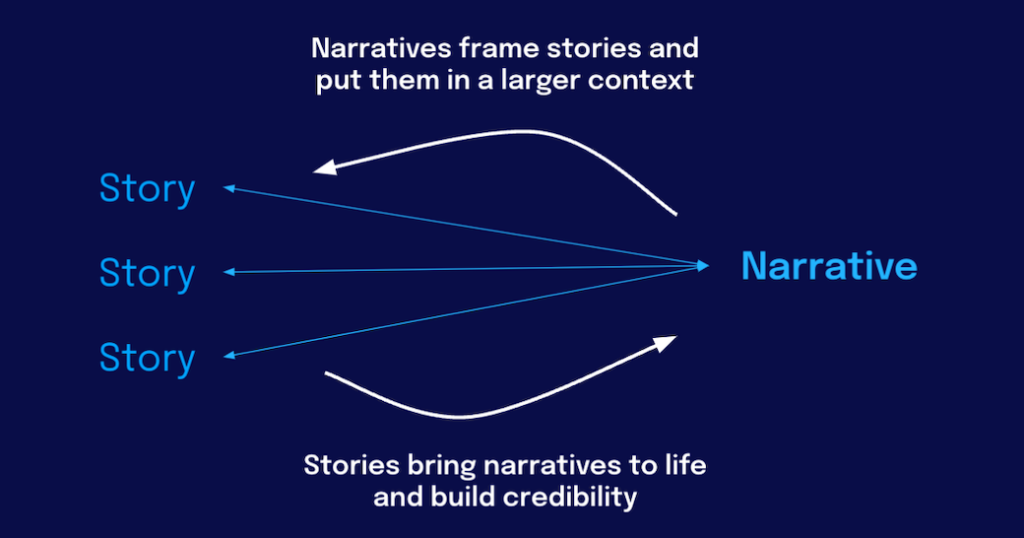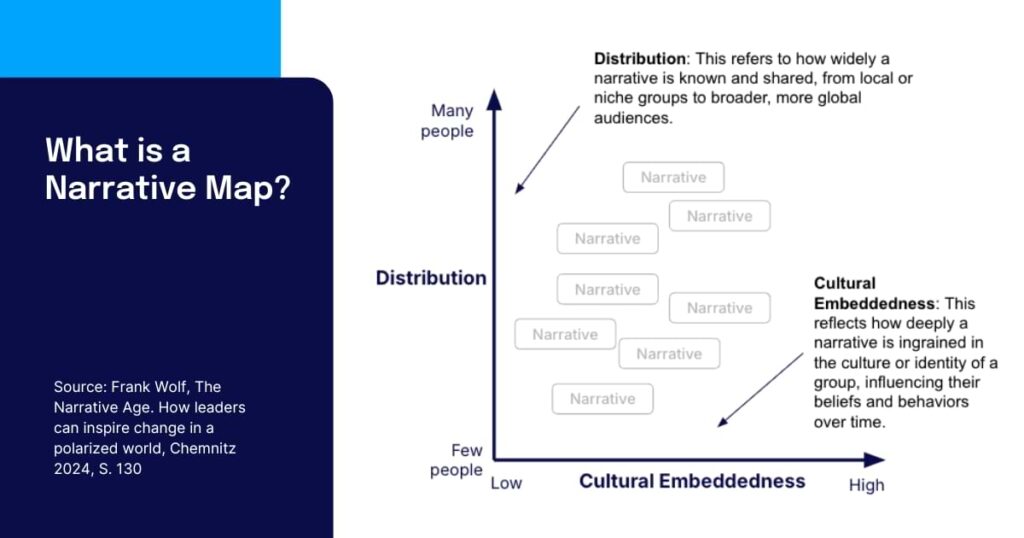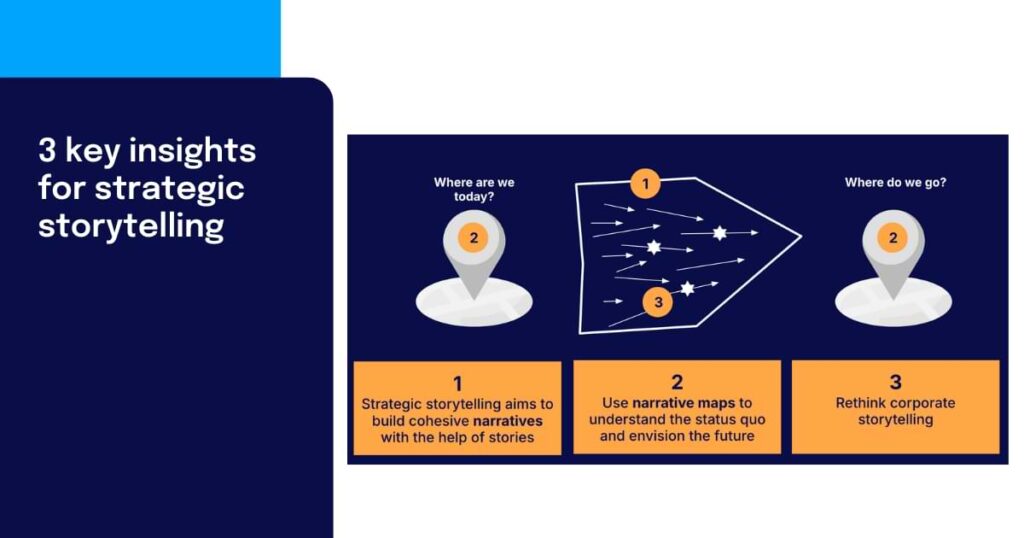In today’s hyper-connected, information-saturated world, narratives have the power to shape perceptions, influence reputation, and define organizational culture. Frank Wolf’s The Narrative Age explores how we are living in an era where stories no longer simply entertain — collectively, they now guide, inform, and inspire action. Unlike simple storytelling, which shares isolated moments, narratives provide an underlying framework that shapes how people interpret events, fostering alignment and engagement across entire organizations. For leaders, mastering narrative strategies has become a key to success in business and communication.
What are narrative strategies in business?
In a business context, narrative strategies are frameworks that guide how organizations craft and communicate their core stories to shape brand perception and strengthen organizational culture. Unlike isolated stories that convey individual events, business narratives create a cohesive structure that aligns messaging across all channels and fosters deeper connections with employees, customers, and stakeholders. Frank Wolf highlights core elements of successful business narratives: a clear purpose, alignment with audience values, and emotional resonance. Together, these elements help communicators develop a brand narrative that not only reflects the organization’s identity but also reinforces trust and engagement within the business environment.
Purpose: Every narrative strategy begins with purpose. Purpose anchors the narrative, providing meaning and direction. For organizations, this means defining why they exist and how they intend to contribute to the world beyond making a profit.
Audience alignment: Effective narratives don’t just speak to audiences — they resonate with them. A successful narrative strategy considers the perspectives, values, and aspirations of its audience. By aligning with what matters to their employees and stakeholders, organizations can create authentic connections.
Emotional resonance: Facts alone rarely inspire action. Emotionally resonant narratives create a sense of belonging, pride, or shared purpose that motivates people to rally behind a cause. For employees, this can mean feeling part of a mission-driven culture, while for customers, it might mean supporting a brand that aligns with their values.
Why narrative strategies matter in today’s communication landscape

In The Narrative Age, Frank Wolf discusses the challenges of communicating in a world where information flows constantly and audiences are more polarized than ever. Traditional one-way messaging — where organizations broadcast messages without engaging in dialogue — no longer works. Instead, successful leaders use narratives to create meaningful connections with diverse audiences.
Frank introduces concepts like “master narratives” and “narrative landscapes” to explain how narratives shape both individual beliefs and collective societal trends. Master narratives are overarching stories shared by groups or societies, such as the ideals of progress, sustainability, or innovation. By aligning their messages with these larger narratives, organizations can position themselves as relevant and forward-thinking players within their industries.
A strong narrative strategy acts like a compass: it keeps communications aligned with both organizational goals and societal values, making them resonate on a deeper level. For example, a company committed to environmental sustainability can align its internal and external messaging with the global narrative of environmental responsibility, making it more likely to engage employees and customers alike who care about this cause.
Real-world examples of narrative strategy in action
Narrative strategies aren’t just theoretical — they are used by real organizations to align their culture, brand, and messaging. Let’s explore a few ways narrative strategy comes to life in real-world settings:
Corporate Social Responsibility (CSR) initiatives
Many organizations now tie their CSR efforts into their larger narrative, framing them as part of a greater mission to make a positive impact on the world. For example, Patagonia’s commitment to environmental protection aligns with its narrative of sustainability and responsibility, making customers feel they are part of a meaningful cause by supporting the brand.
Employer branding
Companies that are intentional about their internal narratives create stronger, more cohesive cultures. A company like Google, for example, crafts its employer brand around the narrative of creativity, innovation, and inclusivity. This narrative not only attracts top talent but also fosters a culture where employees feel they are contributing to something bigger than themselves.
Organizational change and transformation
During times of change, a well-crafted narrative can help employees understand the “why” behind new initiatives and align with the organization’s direction. Microsoft’s recent cultural shift toward openness and collaboration was reinforced by a narrative of transformation and reinvention, helping employees embrace new ways of working that aligned with the company’s vision.
Case study: Staffbase
At Staffbase, narrative alignment has played a key role in improving internal engagement and building trust. By positioning internal communications as a tool for connection and transparency, Staffbase has built a narrative that resonates with employees, reinforcing the company’s commitment to open communication and collaborative culture.
How to create an effective narrative strategy
Building a narrative strategy requires clarity, alignment, and a deep understanding of the audience. Drawing from The Narrative Age, here are actionable steps to help communicators create a compelling narrative that resonates:
1. Define your core purpose
Every narrative begins with a clear purpose. Ask yourself: Why does our organization exist, and what do we want to achieve? This purpose will anchor all communication efforts and provide a meaningful foundation. For instance, a purpose-driven narrative for a healthcare organization might center on patient well-being and medical innovation.
2. Identify your key messages
Craft messages that encapsulate your organization’s values, mission, and unique contributions. These messages should be authentic, memorable, and aligned with the organization’s long-term vision. Aim for clarity and consistency to build trust and create a unified story.
3. Know your audience
Understanding your audience’s needs, values, and perspectives is essential. Conduct audience research to uncover what matters most to them and how they relate to your organization. When you align your narrative with their aspirations, you increase its impact and relevance.
4. Map the narrative landscape
To ensure your narrative is relevant within the broader societal or cultural context, map it within the “narrative landscape.” This involves identifying any existing master narratives (such as sustainability, equality, or innovation) that align with your story. Positioning your organization within these larger themes builds credibility and relevance.
5. Establish a “North Star” narrative
The North Star narrative acts as a guiding principle for your organization’s long-term vision. This central narrative reflects your organization’s highest purpose, motivating both employees and stakeholders to work toward shared goals. A North Star narrative could be about pushing the boundaries of what’s possible, creating lasting impact, or advocating for a sustainable future.
6. Create a narrative map
A narrative map is a tool that helps identify the relationships between your messages and the larger narrative. Use this map to visualize how your organization’s story fits within the broader narrative landscape, ensuring all communications are aligned with both internal goals and external expectations.

7. Engage and adapt
A successful narrative strategy is not static. Engage your audience regularly through feedback and adapt your narrative to stay relevant. As societal and cultural values evolve, ensure your narrative aligns with new developments, reinforcing its authenticity and strengthening trust.
These steps will help you and your organization craft a cohesive narrative strategy that connects on a deeper level, unifying internal and external communications for long-term impact.

The future of narrative in business communication
As organizations move further into The Narrative Age, narrative strategies will become even more essential for creating unified visions, managing reputation, and inspiring loyalty. In the future, leaders and communicators will need to focus not just on what they communicate, but on how their narratives align with the values and goals of their organizations and society as a whole.
A strong narrative strategy will empower organizations to navigate change and foster a resilient culture. Leaders should continually evaluate their narratives, ensuring they stay relevant, resonate with audiences, and align with larger societal narratives. By doing so, they can build a future where communication fosters connection, loyalty, and lasting impact.
